In the first two blog posts of the Factors that Affect Eelgrass Growth in Morro Bay series, we learned that there are many factors that influence eelgrass growth in estuaries. In this two-part post, PhD candidate Erin Aiello explores the importance of light and sediment properties and how they change across the bay.
Erin Aiello, Guest Author
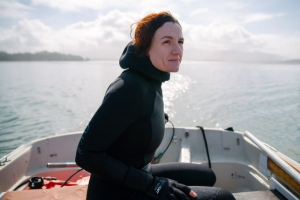
Erin Aiello is a native of the central coast, having grown up in Cambria. She spent most of her childhood running barefoot through pine forests, which instilled in her an undying love of nature. Erin received her BS and MS degrees in Biology from Cal Poly in San Luis Obispo. While she studied at Cuesta College, Erin volunteered at Pacific Wildlife Care as a rehabilitator of sick and injured wildlife. Erin’s love of wildlife led her to pursue ecosystem restoration upon transferring to Cal Poly, as she found restoration to be an impactful way to assist wildlife–and a way that she could connect with plants as well.
Restoration has been the focus of Erin’s research through undergraduate and graduate school. During her MS work, Erin collaborated with the Morro Bay National Estuary Program to perform an experimental eelgrass transplant and to measure parameters in Morro Bay that are important to eelgrass health. Erin is currently studying the role of mycorrhizae in ecosystem restoration at UC Santa Cruz while she pursues a PhD in ecology.
Sediment & Light Differences Across Morro Bay Part 1
Light and sediment both affect eelgrass growth, and can affect one another. Specifically, light is required by plants to make food. If light levels are low in the estuary, eelgrass will not be able to grow. Fine sediment can become suspended in the water, making the water murky and lowering light levels. Sediment can also be too tightly packed for the plants to “breathe,” and chemicals can be too high, while nutrients can be too low. In these two posts, I’ll talk about all three of these variables in Morro Bay: light, sediment texture, and sediment chemistry; and I’ll relate their current state back to the state of eelgrass in Morro Bay.
Sediment
What is soil texture?
Let’s start with soil texture. Soil texture refers to the relative abundances of different sized grains of sediment in a specific location. Sediment texture is important to plants because it determines how easily water, nutrients, oxygen and other gasses can pass through soil, which affects how easy it is for plants that grow in the soil to access these essentials. Sediment texture also determines how easily a plant’s roots can be pulled out of the sediment by wind, waves, grazing animals, water currents, and other disturbances.
If sediment texture is too fine, there is little room between the particles, so gas, nutrient and water exchange at the plant’s roots is limited. Essentially, this makes it difficult for the plant to eat and breathe. If your sediment texture is too coarse, nutrients wash out of the sediment quickly, and plants growing in the soil can easily be removed.
For example, clay has very fine sediment texture and can hold tightly to roots, while sand has coarse particles and cannot. Different plants have their own sweet spot of sediment texture, and for eelgrass, that sweet spot is arguably between one percent and twelve percent clay. There is a scientific consensus that fifteen percent clay is too much clay for sustaining eelgrass.
How do you categorize soil texture?
If you pick up a handful of sand, you can see the different particles very easily. The sand will slip out of your hands. You can’t easily roll it into a ball, and water passes through it very quickly. These are qualities of coarse sediment.
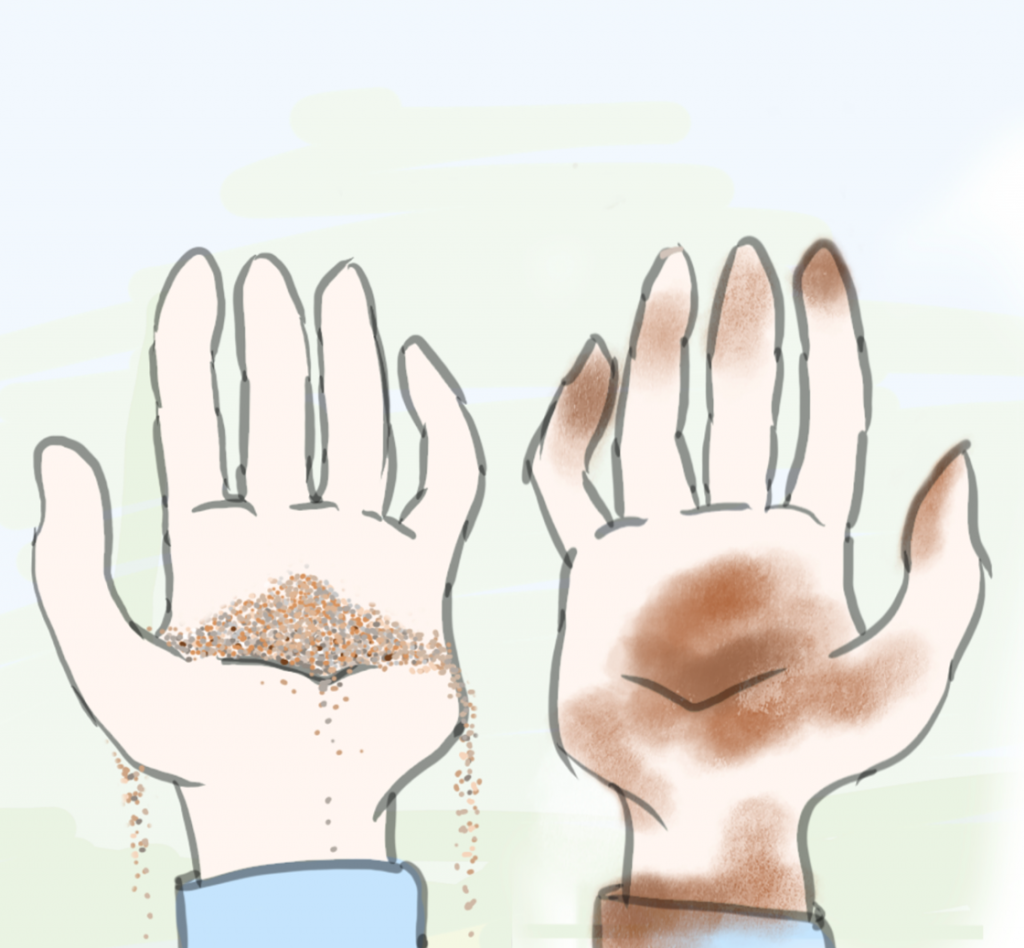
If you pick up a handful of clay, your experience is very different. Clay is composed of tiny particles of sediment. It is difficult to see the different particles. The clay will not slip out of your hands. If it’s wet, it will stick to you, and if it’s dry, it will look like one big, hard clump of earth. You can easily roll wet clay into a ball–or make yourself a mug from it! Water does not easily pass through clay. These are qualities of very fine sediment.
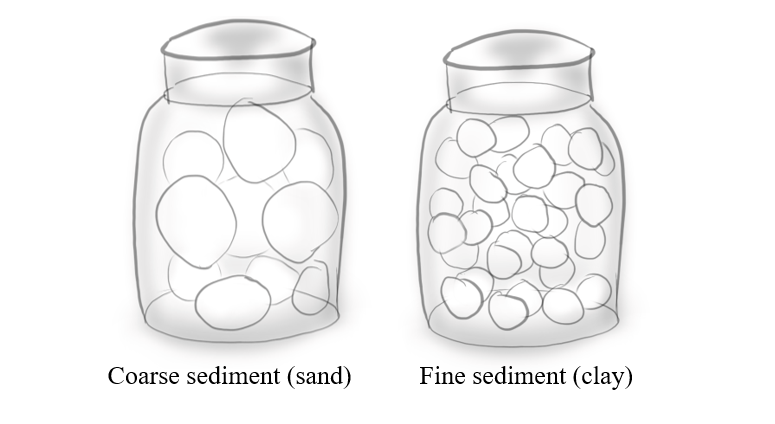
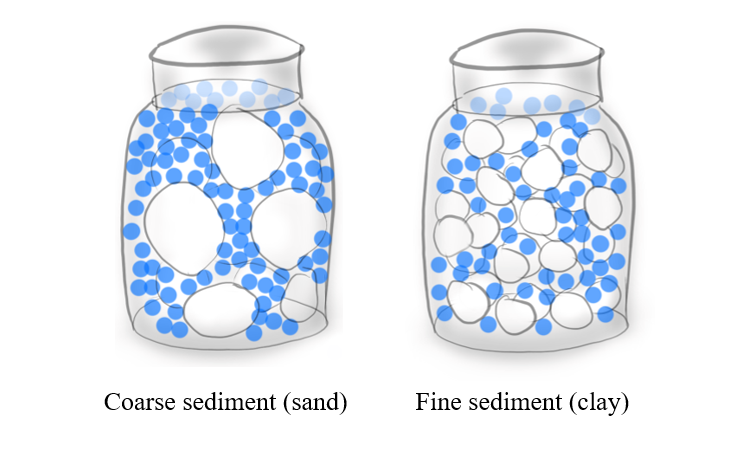
For my graduate research at Cal Poly, I measured sediment texture at seven sites in the Morro Bay Estuary, ranging from Pecho Drive at the far back bay (south) to Coleman Beach near the mouth of the bay (north). Here’s a map of the sites I chose.
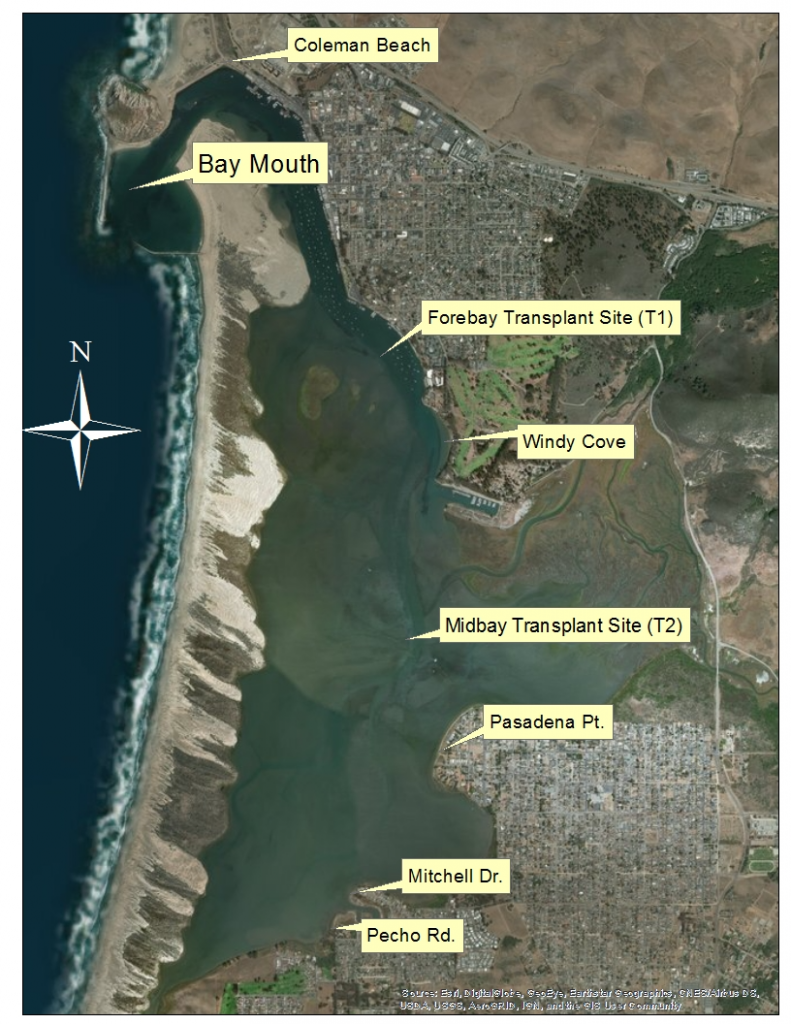
After gathering samples, I analyzed them to determine the percentage of clay in the sediment at each site.
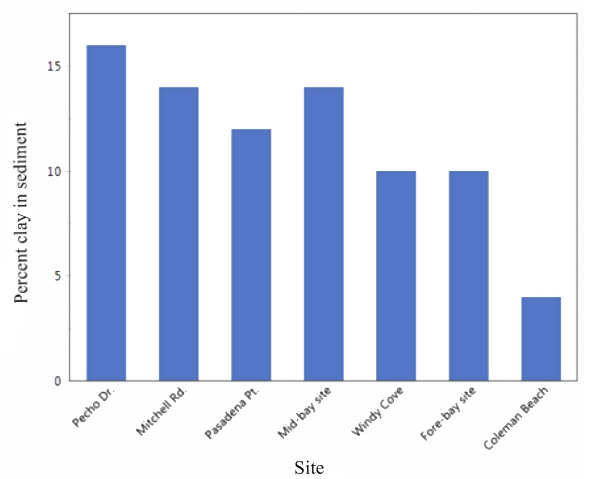
The graph above shows the percentage of clay in the sediment at each of the seven sites, with sites nearest to the back bay, in Los Osos, on the left side and sites nearest to the mouth of the bay, in Morro Bay, on the right side. The height of these bars represent the amount of clay in the sediment. The sample site at Pecho Drive, for example, has sediment that is comprised of about 16% clay. This is a higher amount of clay than is ideal for eelgrass, but eelgrass is still present in some locations near this site. Coleman Beach has sediment comprised of about 4% clay, which is within the ideal range for eelgrass.
The percentage of clay in the sediment increases as you move south, farther from the mouth of the bay. Mitchell Road, Pasadena Point, and the mid-bay site may all be in the danger zone, with more clay than what is suitable to reliably support eelgrass. In short, sediment is much finer in the back bay, which potentially limits nutrient, gas, and water exchange. More research is needed to understand the true impact of sediment texture on eelgrass, as some transplanted eelgrass has persisted in the back bay.
More to come next week
The second part of this post will discuss sediment chemistry and light distribution in Morro Bay, as well as the possible effects of these two factors on eelgrass growth.
Help protect and restore the Morro Bay estuary
- Donate to the Estuary Program today and support our work in the field, the lab, and beyond.
The Estuary Program is a 501(c)3 nonprofit. We depend on funding from grants and generous donors to continue our work. - Support us by purchasing estuary-themed gear from ESTERO. This locally owned and operated company donates 20% of proceeds from its Estuary clothing line and 100% of Estuary decal proceeds to the Estuary Program. Thank you, ESTERO!
- Purchase items from the the Estuary Program’s store on Zazzle. Zazzle prints and ships your items, and the Estuary Program receives 10% of the proceeds. Choose from mugs, hats, t-shirts, and even fanny packs (they’re back!) with our fun Estuary Octopus design, our classic Estuary Program logo, or our Mutts for the Bay logo.
Thank you for your support!